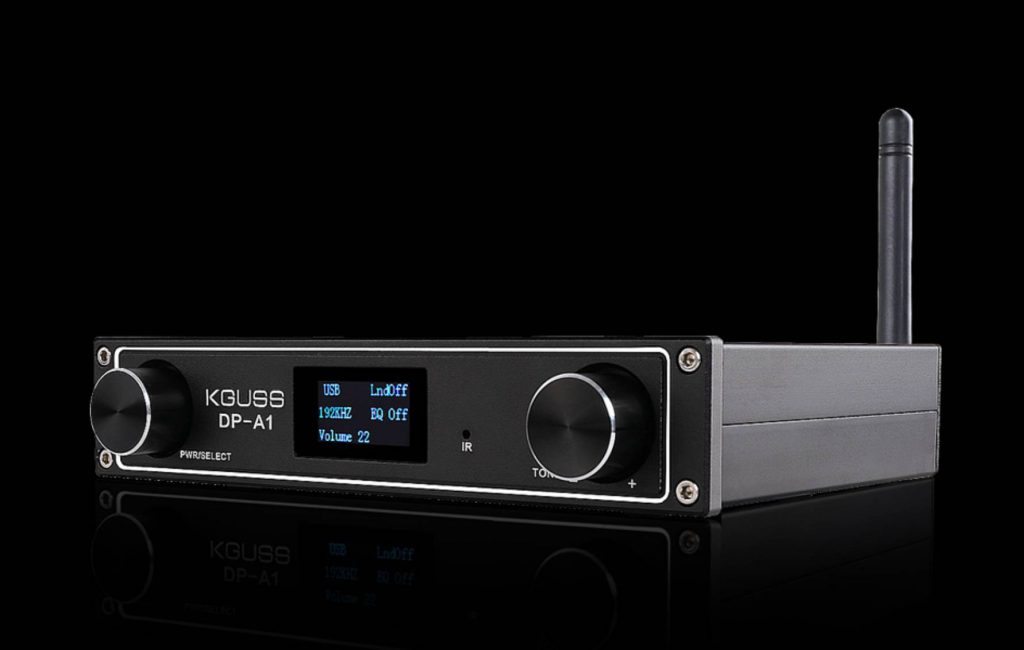Review of the K.Guss DP-A1 Amplifier

- Class D 2.0 Stereo Amplifier
- 20Hz-20Khz ±3dB
- Power output: 120Wx2
- Speaker matching impedance: 4-8Ω
- Sensitivity: 0.2mV
SnR : ≥105dB- THD: ≤0.01%
- ±18 dB Bass and Treble adjuster with EQ presets
- Bit width: 16-24Bit
- Sampling Rate: BT: 24Bit/48Khz; USB/Optical/Coaxial /Aux 44.1-192Khz
- Bluetooth 4.2 24Bit 48Khz APTX
- USB-In 24Bit 192 Khz
- Optical-In 24Bit 192 Khz
- Coaxial-In 24Bit 192 Khz
- Aux-In 24Bit 192 Khz
- TAS5508C DSP
- LM2596
- TAS5352A (125W) Amplifier Chip
- MCU SM59R16G6
- CM6642
- CSR64215 BT4.2
- CS8416 DAC
- WM8782A ADC
- Full Digital Amplifier
- Includes: DP-A1 Unit, Power Adapter (32V), IR Remote, USB Cable, Optical Cable, User Guide, Antenna, Certificate of Conformity
- 185mm L x 125mm D x 35mm H (antenna: 80mm H)
- Weight: 1.6Kg
- Cost: Ali Express (USD 118); Lazada PH (PhP6500)
Here come Chinese amplifiers
Whoever thought that Chinese products were affordable and mostly good? Many of us have a bad image of affordable and cheap Chinese products – they usually perform worse than what we expect from what we paid and have that feeling it won’t last long.
This is the same case with the proliferation of affordable Chinese stereo amplifiers, pre-amplifiers, DACS, and other audio equipment in many countries around the world. A quick search online shows a lot of discussion regarding these Chinese made amplifiers (both high-end and low-end variants):
- An Audiophile Relocates to China: High-End Chinese Speakers?
- Are there many reputable Chinese makers of amplifier?
- What is your experience with Chinese Hifi?
- A Look Inside the Chinese Audio Industry
I read somewhere in the discussion threads on Audio Science Review that Chinese amplifiers started becoming mainstream after a string of good reviews from a French Online Audiophile Forum. Of course, these amps won’t sound as good as the stalwarts for entry Audiophile equipment, more so any serious audiophile amplifiers or those stereo amplifiers for audiophile gods.
But the industry is listening and even, what I would call, higher-end Cambridge Audio has the Topaz AM5 at just USD100 on Amazon. Of course, the really higher-end brands, like PS Audio, have their relatively ‘budget-friendly’ version, Sprout 100 (USD599) is PS Audio’s offering which is really still expensive for someone like me. I think in the same league are brands like NAD, Sony, Emotiva, and even the stereo amplifiers of Marantz. There are also the Rotel’s and such that are just so way out of reach and are in a league of their own. Back to the Topaz AM5, at USD100 it is almost the same price as the K.Guss DP-A1. It might have a lot less watts but I think the sound might just be a notch better, comparing what I have auditioned from the Cambridge CXA60. Here’s another list of the best stereo amplifiers for 2019.
Choosing a budget amplifier in the Philippines
Looking for a budget stereo amplifier was quite difficult. In the Philippines, you are stuck with very affordable Chinese amplifiers, unheard of or very unexciting local brands and then what should have been relatively inexpensive brands (Emotiva’s BasX A-100 for example) but because of importation into the country, are just unreasonable expensive. I would have gone with the Topaz AM5, or an Emotiva Basx A-100 (Class A/B) that is out of stock on Amazon but available on Lazada PH but it is PhP16,200 versus PhP13,000ish (USD249) on Emotiva’s website (at PhP16,000 you can already get an Atmos ready Onkyo TX SR393 on Lazada PH) . At an equal 75 watts per channel, you can get the more affordable Dayton Audio APA150 at PartsExpress for USD145. I’d still go with Cambridge Audio, the looks are sweet. But at 25 watts per channel, it might be underpowering my Tannoy Eclipse 3s. Out the question are also the stereo entry-level Onkyo A9110 (50 watts per channel, PhP 13,950 Lazada PH) or even the Denon PMA-520A (70 watts per channel, PhP14,999 Lazada PH).
In choosing an amplifier, the very basic considerations must be made:
- Do you want a warm, neutral, or bright amplifier?
This can be answered by considering your speakers and then your listening preference. I like to hear the highs and treble of clashing cymbals with a clarity that you can distinguish it slowly disappearing. I also like strong mid-range so that the sound doesn’t feel hollowed and it really helps shape the bass definition. For bass, I like it very tight, no ‘boominess’, responsive, and lively. - How many watts do you need your amplifier to produce?
This depends much on the sensitivity and rated ohms of your speaker. lower ohms means class D amplifiers will have an easier time to pump power into your speakers. Higher sensitivity means that less power is needed to reach SPLs. I found this online calculator by Geoff the Grey Geek to be very useful. Combine that with knowledge on listening levels (discussion on Audiogon, Audiophilestyle, Audiophilereview, r/Audiophile, and Stevehoffman.tv) and the WHO-approved listening levels (Making Listening Safe) and you can sort ofestablish an average listening SPL in dB. Just a trivia, they say that THX certification states SPL reaching 105db (for say, exploding cannons in movies). Using Geoff’s calculator, 10 ft listening position, 85dB SPL, and speaker sensitivity at 90db, I only need 6 watts! (That Topaz AM5 is so convincing, maybe when a relative comes to the Philippines). for THX level peaks I will need 586 watts! - What quantity and quality of connections do you need?
In my case, my requirements were simple, optical-in for my TV, Aux-in for anything else, Bluetooth 4 and up capable of APTX, decent SNR and THD, and at least 30 watts of clean amplification. This is where research is very important. This is because the Chinese amplifiers are a hodgepodge collection of chips on a circuit board! You need to know the technical specifications of each of the chips so that you are certain of the qualitative aspects of sound output from quantitative measurements made in the specification sheets of the manufacturer’s chips. One example is looking at when THD becomesunnaceeptable at the wattage range that you require for your specific listening SPL.

In doing research for a stereo amplifier less than or somewhere near USD100 (PhP5200) the following Chinese amplifier came up at the top:
- SMSL AD18 | PhP7,163 Lazada PH |One of the more popular higher-rated Chinese amplifiers. This has 80 watts per channel at 4 ohms (so much lower at 8 ohms and remember the THD), it also has BT 4.2 with APTX, has coaxial, optical, aux, even a subwoofer out, and ±8 bass and treble adjuster. The
microUSB input is 24Bit but at 96Khz only. It is also a full digital amplifier. You can read the reviews [1][2][3][4] for what people think about how it actually sounds. - Topping MX3 | PhP5,200 Lazada PH | Topping is known for their better quality equipment compared to SMSL. The Topping MX3 though is rated at only 38 watts per channel at 8 ohms but at a THD of 10% (so in reality, you have to check the amplifier chip specifications to see the THD vs Watt graph). ASR, mentions that this is not a full digital amplifier. It has BT4.0 without APTX support, coaxial, aux, optical, and USB input, and also a subwoofer RCA output. The reviews are found here [1][2][3].
Other Chinese amplifiers that I considered included:
- FX Audio D802C Pro Wireless | PhP6,205 Lazada PH | FX Audio is a Shenzhen based audio equipment manufacturing company, they are quite known.
- FX Audio D502 | PhP5,500 Lazada PH | 45
w atts per channel at 8 ohms no Bluetooth.
So why did I end up with the K.Guss DP-A1? Very simple. I am a very logical person, so I was glad that Audio Science Review had evaluated both SMSL AD18 and Topping MX3. From there I extrapolated based on the chipsets used how the K.Guss might perform. I also put into consideration the price points – I was able to purchase my DP-A1 at PhP5,812 with free shipping. What did the Audio Science Review say o the SMSL AD18? Here are some of the reactions of members of the forum to the results of the evaluation:
WOW[,] this is horrible performance… SMSL devices really haven’t delivered outside of a few “flagship” products.
Jimster480, Apr 17, 2019
Not the idea of excellence in audio indeed…
Demes, Apr 16, 2019
you couldn’t imagine the hype on the french forums. Actually thousands of pages that extol the qualities of fda, and those of the AD18 in particular.
Andrex, Apr 16, 2019
I won’t look at my AD18 the same way now.
Daftcombo, Apr 17, 2019
I[t] sounds good enough on speakers in a small room though.
SMSL proves to be Topping’s erratic cousin yet again
Sssn, Apr 17, 2019
And what about of the Topping MX3? What were the reaction of the members of the Audio Science Review forum to the results of the evaluation of the Topping MX3?
Disappointed by the high distortion >1kHz. If you were to do SINAD measurements at 10kHz, what would that be?
Mzkm, Apr 15, 2019
That is quite dissapointing performance, in comparison to their very impressive D10 and D30 DACs at least, but of course at this price point one must temper their expectations, given how much functionality is crammed into a very compact box.
Demes, Apr 15, 2019
I actually have an MX3 and im running some EXTREMELY clear speakers on it that would show this distortion easily.
Fireboltr, Apr 15, 2019
Mine actually has an audibly cleaner output than the Rotel RB-981 that the MX3 took the place of….
Although I am running off the optical not usb and according to Topping’s specs the optical can do more…
If the budget is limited to say 1k$ then it makes more sense to go with the MX3 and invest the remaining budget into speakers. There are probably very few speakers in this price range which are able to reveal the problems of the MX3.
LTig, Apr 15, 2019
K.Guss DP-A1
I purchased my K.Guss DP-A1 from Lazada on August 19 and got it on August 24 for 5-days of shipping time. It cost me just PhP5812 or USD112. Here are some pictures of the unboxing below.
Well how does it sound? For the money I paid I would say it gives clean power that’s a bit on the neutral. I would appreciate more weight in the delivery of the mid-range, The bass delivery is good and clear and the high are well amplified as well. It definitely has no problem powering my Tannoy Eclipse 3s – no clipping. My only odd observation is that I regularly have the volume at 70-80 with the amplification source at maximum to get chest thumping loud, with regular listening at around 70. My listening room is actually the living room which connects to the dining area and has an opening to the kitchen – the living and dining is approximately 45 square meters. I don’t know if its normal that I have to keep the volume knob so high – does it mean that it is already providing near capacity output at 57 watts unclipped power per channel at 8 ohms (1% THD 6.9.1 of the TAS5352A datasheet)? I will need an SPL meter to see what dB I am at those levels and come to a more scientific assessment of what watt and SPL I am listening to – I can’t quite get my finger on it! Although, they do mention that these knobs act more geometrical than linear.
My Rating





For the PhP5,812 I paid for the DP-A1, I am satisfied – it has all the connections I need and powers my Tannoy Eclipse 3s just fine (check my review of those floor standing speakers here). I can’t give it 5 stars because it just doesn’t have the kick and the beef compared to my ideal reference the Cambridge CXA60 (What HiFi? 5/5 2016) which I heard my Tannoys paired with when I auditioned them. Hope you enjoyed my review of the K.Guss DP-A1 and learned something new! If you are considering this amplifier, I hope I helped you narrow down your decision-making. Let me know what you think or if you have questions about my review or of the DP-A1 by leaving a comment below.
